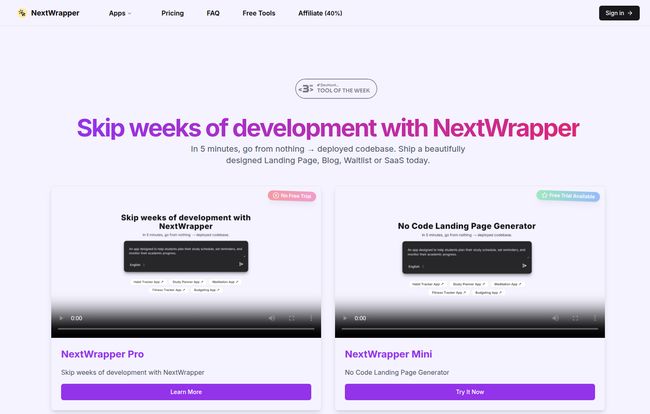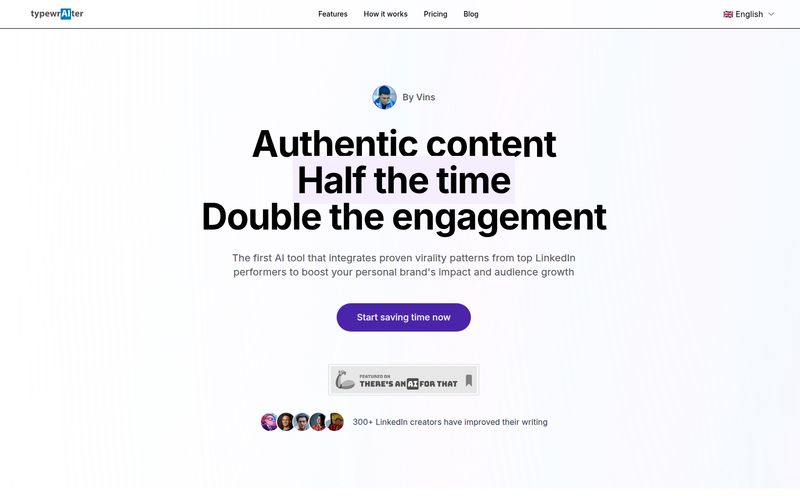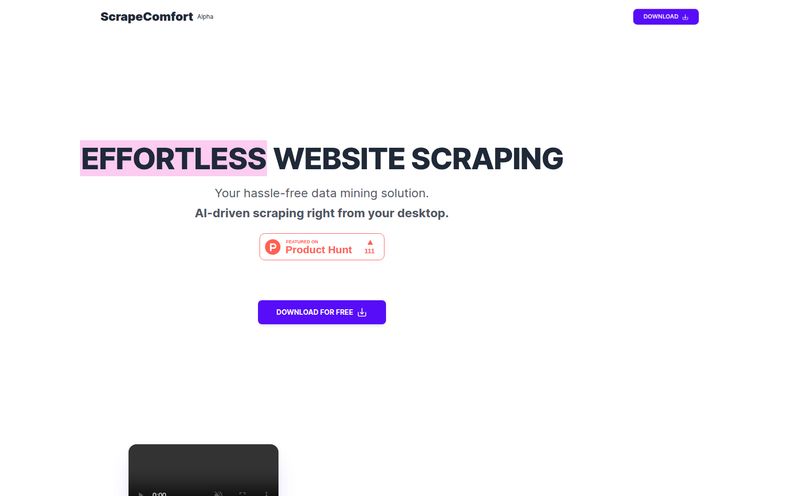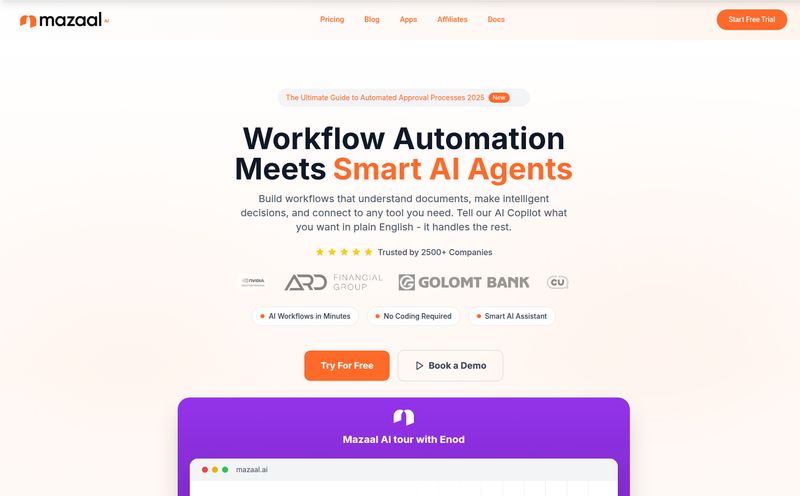How many times have you had a brilliant idea for a SaaS app, gotten all hyped up, bought the domain... and then stared at an empty code editor with a creeping sense of dread?
The excitement of the idea quickly gets buried under the mountain of setup. User authentication. Billing integration. A decent-looking landing page. A dashboard. It's the same song and dance every single time. It’s the digital equivalent of having to build the factory before you can even design the product. Frankly, it’s a drag. I’ve personally abandoned projects in this phase, not because the idea was bad, but because my motivation just fizzled out dealing with the grunt work.
So when I stumbled upon a tool called NextWrapper, my cynical developer brain perked up. It promises to “skip weeks of development” by generating a full Next.js codebase for you. Not just a template, but a functioning app foundation, complete with AI-written copy. My first thought? “Yeah, right.” But my second thought, the one from the part of me that desperately wants to build cool stuff faster, was, “...tell me more.”
So I did what any self-respecting SEO and tech nerd would do. I went down the rabbit hole. And this is my no-fluff, hands-on take on whether NextWrapper is the real deal or just another shiny object in the ever-growing pile of dev tools.
So, What on Earth is NextWrapper?
At its heart, NextWrapper is a supercharged boilerplate generator for Next.js applications. Think of it less like a simple template you clone from GitHub and more like an AI-powered apprentice that does the boring first draft of your entire application infrastructure for you. You tell it about your app idea, and in minutes, it spits out a deployed codebase with all the essential, non-negotiable pieces already wired up.
We’re talking about a tool designed for speed. It’s built for the indie hacker trying to launch a product over a weekend, the startup that needs to validate an idea before burning through cash, and the freelance developer who wants to give their clients a massive head start. It’s about shifting your focus from building the plumbing to actually creating the unique, value-adding features of your app. A pretty compelling proposition, if you ask me.

Visit NextWrapper
The Features That Genuinely Make a Difference
A feature list is just a list. What I care about is whether those features actually solve a real-world problem. Here’s the breakdown of what NextWrapper bundles together, and my take on why it matters.
AI-Powered Copy for Your Landing Page
This one is the secret sauce. Most boilerplates give you a layout with `lorem ipsum` text. You’re still on the hook for writing compelling marketing copy, which, for many developers, is like pulling teeth. NextWrapper asks you for details about your app and then uses AI to generate the headlines, feature descriptions, and CTAs. Is it going to win a Pulitzer? Probaly not. But is it a million times better than a blank page and a blinking cursor? Absolutely. It gets you 80% of the way there, and you can just tweak and refine it. That alone is a huge mental hurdle cleared.
The “Boring Stuff” Handled: Auth and Billing
If I had a dollar for every time I had to implement user login, I’d have... well, a lot of dollars. NextWrapper comes with authentication pre-built, including credentials (email/password), Google, and Microsoft logins. That’s a massive time-saver and a security headache you don’t have to think about on day one.
Then there’s the billing. They’ve integrated with Lemonsqueezy, which has become a darling in the indie developer community for good reason. It acts as a merchant of record, which means it handles all the messy sales tax and VAT stuff for you. Integrating payments is notoriously finicky, so having this ready to go from the get-go is just fantastic.
A Ready-Made Dashboard and Custom Components
Once a user signs up and pays, they need a place to land. NextWrapper generates a user dashboard and account settings pages for you. Again, this is foundational stuff you’d have to build anyway. The components are designed to be customizable, so you’re not stuck with a rigid, unchangeable theme. You get a full codebase, not a black box, so you can dive in and change whatever you dont like.
NextWrapper's Pricing Structure
Alright, let's talk money. Speed and convenience are great, but what’s the damage? The pricing model is pretty straightforward, which I appreciate. There are essentially two tiers to think about.
| Plan | Price | What You Get | My Take |
|---|---|---|---|
| NextWrapper Mini (Monthly) | $15 /month | Unlimited landing page generation with auth integration. | This feels like the “test the waters” plan. Great if you just want to quickly spin up a beautiful landing page to validate an idea and collect sign-ups. |
| NextWrapper Pro (Yearly) | $160 /year | The whole shebang: unlimited boilercode for landing pages, waitlists, dashboards, billing, and auth. The image mentions lifetime updates which is huge. | This is the main event. If you’re serious about building a full SaaS, this is the one. For the amount of time it saves, $160 is an absolute steal. That’s maybe 2-3 hours of a freelance developer’s time. |
One critical thing to note, and they’re up front about it: there are no refunds. This makes sense from their perspective—once you generate the code, you have it forever. But it means you should be pretty sure it's the right tool for you before you click “buy.”
The Good, The Bad, and The Next.js
No tool is perfect. After digging through everything, here’s my balanced take on where NextWrapper shines and where you might want to pause for thought.
What I Really Like
The core value proposition—speed—is undeniable. The difference between starting with NextWrapper and starting from scratch is the difference between getting on a moving walkway at the airport versus walking the whole terminal. You’re still going to the same place, but one way is a hell of a lot faster and less tiring.
I also think the feature set is incredibly well-chosen. It’s not bloated with things you don't need. It’s a curated collection of the exact things every SaaS founder needs at the beginning. Auth, payments, a landing page, a dashboard. That’s the magic recipe.
Some Things to Keep in Mind
The no-refund policy is the big one. It’s a commitment. Also, this is obviously a tool for the Next.js ecosystem. If you’re a die-hard fan of SvelteKit, Remix, or something else, this isn’t for you. That’s not a flaw; it’s a specialization. But it’s a critical decision point. You’re buying into the Next.js and Vercel way of doing things.
Finally, and this is important, NextWrapper is a launchpad, not a spaceship. It gets you off the ground, but you still have to fly the thing. You need to build the actual, unique core of your product. This tool doesn't build your business for you; it just clears away the jungle of boilerplate so you can start building on solid ground.
Who Is This Tool Actually For?
So, who should drop the $160? In my opinion, the ideal NextWrapper customer is:
- The Indie Hacker: You have more ideas than time. You want to build and launch quickly to see what sticks, without reinventing the wheel every time.
- The Early-Stage Startup: You need an MVP, like, yesterday. You need to show traction to investors or early customers without spending your limited runway on foundational code.
- The Pragmatic Developer: You know how to build all this stuff, but you’d rather spend your brainpower on the unique business logic of your application. You value your time more than the cost of the boilerplate.
Conclusion: A No-Brainer for a Modern Builder?
After spending time with NextWrapper, my initial cynicism has mostly melted away. It's a sharp, focused tool that understands its audience perfectly. It's not trying to be everything to everyone. It's for Next.js developers who want to build and ship faster. Full stop.
In a world where speed of execution is a major competitive advantage, tools like NextWrapper feel less like a luxury and more like a necessity. For the price of a nice dinner out, you can buy back weeks of your life. For me, that's a trade I'd take any day of the week. It’s a powerful accelerator that lets you focus on what truly matters: building something awesome.
Frequently Asked Questions
Is NextWrapper a no-code tool?
Not exactly. It’s a low-code tool or a code generator. It writes the initial code for you, but you get a full, professional-grade Next.js codebase that you are expected to edit and build upon. You'll need coding knowledge to use it effectively.
What is the technology stack of the generated app?
It’s built on the modern developer's favorites: Next.js for the framework, React for the UI, and likely Tailwind CSS for styling, given the focus on customizable components. It also integrates with specific services like Lemonsqueezy for payments.
Can I fully customize the code NextWrapper generates?
Yes, 100%. That's the main benefit over a locked-in platform. You receive the complete source code, so you have total freedom to change, add, or remove anything you want.
What’s the main difference between the monthly and yearly plans?
The monthly plan ($15/mo) is focused on generating a landing page with user authentication. It's for collecting leads and validation. The yearly plan ($160/yr) gives you the full SaaS boilerplate, including a user dashboard, account pages, and billing integration.
Is there a free trial available?
Based on the available information, there doesn't appear to be a free trial for the Pro version, which is likely tied to their no-refunds policy. Once you generate the code, it’s yours.
Why is there a strict no-refund policy?
While not officially stated, this is common for products that deliver digital source code. Once you download the codebase, there's no way to truly “return” it. The value is delivered instantly and irrevocably.
Reference and Sources
- NextWrapper Official Website
- NextWrapper Pricing Page
- Next.js by Vercel
- Lemonsqueezy Payment Platform



